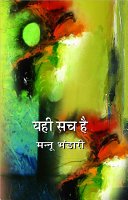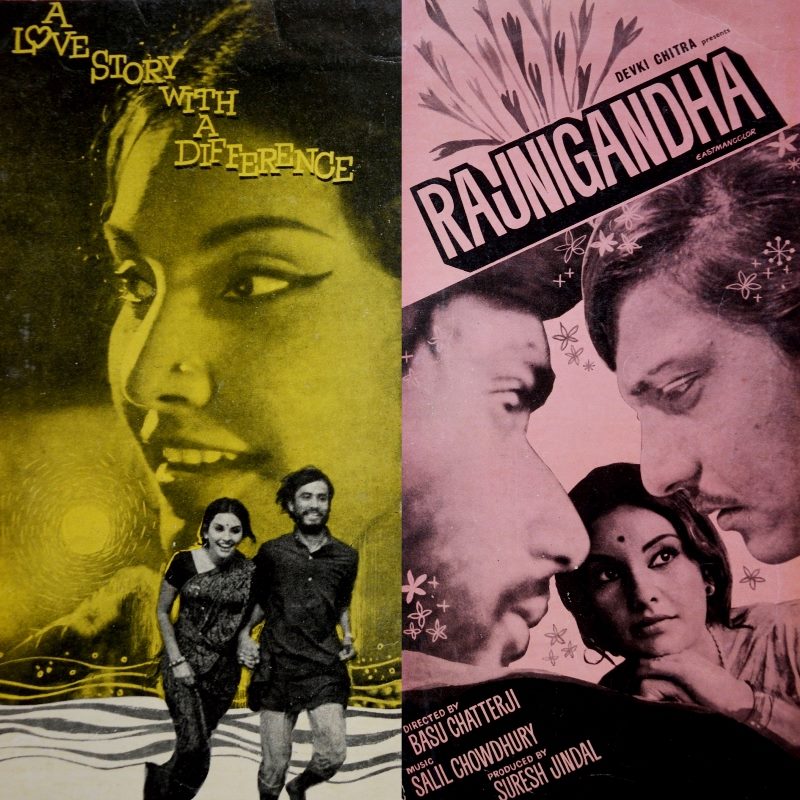“Kai baar yun bhi dekha hai, ye jo mann ki seema-rekha hai mann todne lagta hai (so it often happens, the heart transgresses its boundaries),” sung by the dreamy voiced Mukesh makes for an apt description of Basu Chatterjee’s movie Rajnigandha (1974), based on a Hindi short story by Mannu Bhandari titled ‘Yahi Sach Hai (This is the Truth)’. The story is primarily about a woman reflecting on the uncertainty of her emotional attachments whilst undertaking a meaning making process of her educated and modern self along with the internalised idea of imagining her identity always in relation to the love interest in her life. In this essay, I will try to compare both the art pieces by looking at the differences between their portrayal of women.
Finding a Woman’s Narrative in Mannu Bhandari’s Yahi Sach Hai
Bhandari whose writings have been called feminist for their exploration of raw feminine sexuality and internal conflicts, wrote this short story in 1966, at a time when the country was in a state of churning with incoming western influences and a newly emerged class of people with modern education and more liberal outlook towards life, but at the same time the majority of the nation was still adhering to the traditional rule book.

The Indian feminist movement was then moving ahead from the concerns of Sati, widow remarriage towards demanding more legal rights for women in the workplace and self-assertion by occupying more public space. Meanwhile in the realm of Hindi literature, a new genre called ‘Nayi Kahani (New story)’ was established by writers like Mannu Bhandari, Krishna Sobti, Rajendra Yadav etc., where the internal agonies of the characters were given priority and the focus was shifted to a more micro analysis of man-woman relationship away from the mainstream themes of raw nationalism etc.
The protagonist of the story on which Rajnigandha is based, Deepa (played brilliantly by Vidya Sinha), a research scholar is trying to make sense of the essentiality of companionship, her past experience of heartbreak and the never-ending loneliness that not just arrives with the end of a romantic adventure but something which is present even when lovers are around. She and her partner Sanjay (played by the charming Amol Palekar) are waiting for her to get a job so that they can start a conjugal relationship. She travels to Calcutta for a job interview where she encounters Nishith (played by Dinesh Thakur), a former lover who assists her during the whole process and shows her around the city where they share some moments of togetherness, leaving Deepa confused about her feelings for the two men in her life.
The protagonist of the story, Deepa (played brilliantly by Vidya Sinha), a research scholar is trying to make sense of the essentiality of companionship, her past experience of heartbreak and the never-ending loneliness that not just arrives with the end of a romantic adventure but something which is present even when lovers are around. “
To make sure that the reader is familiar with not just what she is saying out loud but what she is feeling internally, Bhandari continuously uses a stream of consciousness (which is included in the film in the form of multiple internal monologues). Deepa is equipped with agency, even in her indecision, because of the trivial but unconventional life choices that she has made and her acceptance (even though hesitant) of her complicated desire.
Here is an intellectually sound and independent woman who also invests emotionally and sexually in her relations. The writer doesn’t make it a choice for her to either be emotional or smart. One can be both or neither. We find her fancying romantic love without losing hold of practicality by continuously reminding herself of worldly truths and the importance of economic independence in a woman’s life.

Contextualizing Chatterjee’s Cinema
Basu Chatterjee’s ‘Rajnigandha’ came out almost a decade later from the year of publication of Bhandari’s story. India was then headed by Prime Minister Indira Gandhi, a new chapter in its political history being led by a woman for the first time. But Indian cinema was still covered with potboilers and larger than life movies like Sholey, Zanjeer etc.
Chatterjee along with directors like Mrinal Sen and Shyam Benegal brought a more realistic aspect of human life on screen that became a part of the parallel cinema movement. With this movie, Chatterjee became a familiar name in the middle-class cinema going audience, probably a result of the changes that he made in his film adaptation of ‘Yahi Sach Hai’ by bringing the story closer to the urban, Hindu middle class ideals of marriage and women’s emancipation.
A Win for the Brahmanical Middle-Class Morality?
A ‘feminist criticism’ of Rajnigandha shows that it indulges in an effort to make Deepa’s character more socially acceptable by subtly removing the important socio-cultural underpinnings which were present in Bhandari’s story. Unlike the film where Deepa is shown to be living with her brother and sister-in law in Delhi, in the original story, she lives alone in the provincial city of Kanpur with very little contact
with her natal family and is regularly visited by her partner Sanjay. During the course of the written story, they explicitly engage in physical intimacy, multiple times, which in the film is replaced by occasional physical contact and the title track “Rajnigandha” where she is shown sensually embracing a bunch of tuberoses that Sanjay gave her, which embodies her desires.
Also read: Middle class morality dictates the conversations around sexuality in India
Even though both the film and the story doesn’t mention caste anywhere, by looking at this change, from a Dalit-Marxist lens one can comment that it has always been difficult for the upper classes which in Indian context are majorly the upper castes, to associate modernity and education with the lower classes and castes, specially the ones who are living in provincial areas. The life choices of the working classes and the lower castes have always been stigmatised and looked down upon in terms of their culture and seen as more conservative as compared to the ones living in cities with better economic conditions. And to show a woman of that social location nurture sexual fantasies for two men at the same time might had been too tabooed a topic for Chatterjee to portray in Rajnigandha.
The life choices of the working classes and the lower castes have always been stigmatised and looked down upon in terms of their culture and seen as more conservative as compared to the ones living in cities with better economic conditions and to show a woman of that social location nurture sexual fantasies for two men at the same time might had been too tabooed a topic for Chatterjee to show on screen.

Rajnigandha plays it safe by trying to uphold the Brahmanical and majoritarian idea of marriage intact. It ends with Deepa getting the job she was interviewed for, but then leaving it asking Sanjay to create a new world for her. Of course, till then, we become more or less friends with Deepa and understand that she is hurt because her rekindled affection for Nishith has not been reciprocated by him and being with Sanjay might prove to be helpful for her mental and emotional health, just like it did when she first started seeing him.
This was a method used by the director to, in a way, legitimize all those moments of romance between the couple before they entered the institution of marriage. It also calls out the conservative understanding around the validity of a love relationship based on where it leads to in the future.
Saving Grace
Even then Rajnigandha remains progressive by distancing the camera away from a “male gaze” and giving the female lead maximum screen time as demanded by the story. In an era, where male leads in films were driven by savior complex, Chatterjee’s portrayal of men is relatively nuanced and well outside the prism of hyper-masculinity. The director has beautifully used modern ‘feminist geography’ and numerous scenes where Deepa is seen loitering outside the physical domestic space as a way to portray the changing social realities with women occupying more public spaces. The film brought a fresh representation of heterosexual romance as it offers no simple explanation of affection and leaves it as a complicated idea which is how love most of the times is.
Also read: Does Simply Having Female Protagonists Mean That A Film Is Feminist?
Unlike most of its contemporaries, the woman in the film was not a passive receiver of romantic gestures but rather aware and expressive of her desires. The heroine and the heroes don’t break into soppy songs or dance numbers out of the blue anywhere in the movie. For lovers who have romanced or are still romancing in the cities of Delhi and Mumbai, the film is bound to invoke nostalgia.
References
Featured Image Source : Instagram
About the author(s)
Aparna is a post-grad student of Women's Studies at TISS, Hyderabad. When she is not talking about intersectional politics and re-reading The God of Small Things, she can be found listening to Mehdi Hassan while she pets cats and collects yellow flowers.




